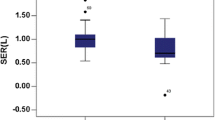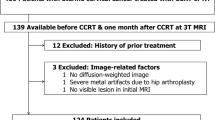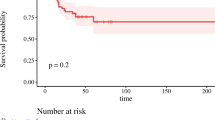Abstract
Purpose
This study investigated predictors of cervical cancer (CC) recurrence from native T1 mapping, conventional imaging, and clinicopathologic metrics.
Patients and Methods
In total, 144 patients with histopathologically confirmed CC (90 with and 54 without surgical treatment) were enrolled in this prospective study. Native T1 relaxation time, conventional imaging, and clinicopathologic characteristics were acquired. The association of quantitative and qualitative parameters with post-treatment tumor recurrence was assessed using univariate and multivariate Cox proportional hazard regression analyses. Independent risk factors were combined into a model and individual prognostic index equation for predicting recurrence risk. The receiver operating characteristic (ROC) curve determined the optimal cutoff point.
Results
In total, 12 of 90 (13.3%) surgically treated patients experienced tumor recurrence. Native T1 values (X1) [hazard ratio (HR) 1.008; 95% confidence interval (CI) 1.001–1.016], maximum tumor diameter (X2) (HR 1.065; 95% CI 1.020–1.113), and parametrial invasion (X3) (HR 3.930; 95% CI 1.013–15.251) were independent tumor recurrence risk factors. The individual prognostic index (PI) of the established recurrence risk model was PI = 0.008X1 + 0.063X2 + 1.369X3. The area under the ROC curve (AUC) of the Cox regression model was 0.923. A total of 20 of 54 (37.0%) non-surgical patients experienced tumor recurrence. Native T1 values (X1) (HR 1.012; 95% CI 1.007–1.016) and lymph node metastasis (X2) (HR 4.064; 95% CI 1.378–11.990) were independent tumor recurrence risk factors. The corresponding PI was calculated as follows: PI = 0.011X1 + 1.402X2; the Cox regression model AUC was 0.921.
Conclusions
Native T1 values combined with conventional imaging and clinicopathologic variables could facilitate the pretreatment prediction of CC recurrence.



Similar content being viewed by others
References
Ferlay J, Soerjomataram I, Dikshit R, et al. Cancer incidence and mortality worldwide: sources, methods and major patterns in GLOBOCAN 2012. Int J Cancer. 2015;136:E359–86.
Bray F, Ferlay J, Soerjomataram I, Siegel RL, Torre LA, Jemal A. Global cancer statistics 2018: GLOBOCAN estimates of incidence and mortality worldwide for 36 cancers in 185 countries. CA Cancer J Clin. 2018;68:394–424.
Wang PY, Thapa D, Wu GY, Sun Q, Cai H, Tuo F. A study on diffusion and kurtosis features of cervical cancer based on non-Gaussian diffusion weighted model. Magn Reson Imaging. 2018;47:60–6.
Luvero D, Plotti F, Lopez S, et al. Antiangiogenics and immunotherapies in cervical cancer: an update and future’s view. Med Oncol. 2017;34:115.
Grigsby PW. The prognostic value of PET and PET/CT in cervical cancer. Cancer Imaging. 2008;8:146–55.
Li N, Sun Q, Yu Z, et al. Nuclear-targeted photothermal therapy prevents cancer recurrence with near-infrared triggered copper sulfide nanoparticles. ACS Nano. 2018;12:5197–206.
Brambs CE, Höhn AK, Hentschel B, Fischer U, Bilek K, Horn LC. The prognostic impact of grading in FIGO IB and IIB squamous cell cervical carcinomas. Geburtshilfe Frauenheilkd. 2019;79:198–204.
Kilic F, Cakir C, Yuksel D, et al. Analysis of the prognostic factors determining the oncological outcomes in patients with high-risk early-stage cervical cancer. J Obstet Gynaecol. 2022;42:281–8.
Guo Q, Zhu J, Wu Y, et al. Predictive value of preoperative serum squamous cell carcinoma antigen (SCCeAg) level on tumor recurrence in cervical squamous cell carcinoma patients treated with radical surgery: a single-institution study. Eur J Surg Oncol. 2020;46:131–8.
Zhang Q, Guo J, Ouyang H, Chen S, Zhao X, Yu X. Added-value of dynamic contrast-enhanced MRI on prediction of tumor recurrence in locally advanced cervical cancer treated with chemoradiotherapy. Eur Radiol. 2020;32:2529–39.
Gladwish A, Milosevic M, Fyles A, et al. Association of apparent diffusion coefficient with disease recurrence in patients with locally advanced cervical cancer treated with radical chemotherapy and radiation therapy. Radiology. 2016;279:158–66.
Heo SH, Shin SS, Kim JW, et al. Pre-treatment diffusion-weighted MR imaging for predicting tumor recurrence in uterine cervical cancer treated with concurrent chemoradiation: value of histogram analysis of apparent diffusion coefficients. Korean J Radiol. 2013;14:616–25.
Adams LC, Ralla B, Jurmeister P, et al. Native T1 mapping as an in vivo biomarker for the identification of higher-grade renal cell carcinoma correlation with histopathological findings. Invest Radiol. 2019;54:118–28.
Hueper K, Peperhove M, Rong S, et al. T1-mapping for assessment of ischemia-induced acute kidney injury and prediction of chronic kidney disease in mice. Eur Radiol. 2014;24:2252–60.
Li J, Gao X, Dominik Nickel M, Cheng J, Zhu J. Native T1 mapping for differentiating the histopathologic type, grade, and stage of rectal adenocarcinoma: a pilot study. Cancer Imaging. 2022;22:30.
Qin X, Yang T, Huang Z, et al. Hepatocellular carcinoma grading and recurrence prediction using T1 mapping on gadolinium-ethoxybenzyl diethylenetriamine pentaacetic acid-enhanced magnetic resonance imaging. Oncol Lett. 2019;18:2322–9.
Riley RD, Ensor J, Snell KIE, et al. Calculating the sample size required for developing a clinical prediction model. BMJ. 2020;368:m441.
Koh WJ, Abu-Rustum NR, Bean S, et al. Cervical cancer, version 3. 2019, NCCN clinical practice guidelines in oncology. J Natl Compr Canc Netw. 2019;17:64–84.
Csutak C, Ordeanu C, Nagy VM, et al. A prospective study of the value of pre- and post-treatment magnetic resonance imaging examinations for advanced cervical cancer. Clujul Med. 2016;89:410–8.
Narayan K, McKenzie A, Fisher R, Susil B, Jobling T, Bernshaw D. Estimation of tumor volume in cervical cancer by magnetic resonance imaging. Am J Clin Oncol. 2003;26:e163–8.
Lee DW, Kim YT, Kim JH, et al. Clinical significance of tumor volume and lymph node involvement assessed by MRI in stage IIB cervical cancer patients treated with concurrent chemoradiation therapy. J Gynecol Oncol. 2010;21:18–23.
Thoms WW Jr, Eifel PJ, Smith TL, et al. Bulky endocervical carcinoma: a 23-year experience. Int J Radiat Oncol Biol Phys. 1992;23:491–9.
Jiamset I, Hanprasertpong J. Risk factors for parametrial involvement in early-stage cervical cancer and identification of patients suitable for less radical surgery. Oncol Res Treat. 2016;39:432–8.
Yang Q, Zhou Q, He X, et al. Retrospective analysis of the incidence and predictive factors of parametrial involvement in FIGO IB1 cervical cancer. J Gynecol Obstet Hum Reprod. 2021;50:102145.
Kim SH, Choi BI, Lee HP, et al. Uterine cervical carcinoma: comparison of CT and MR findings. Radiology. 1990;175:45–51.
Woo S, Kim SY, Cho JY, Kim SH. Apparent diffusion coefficient for prediction of parametrial invasion in cervical cancer: a critical evaluation based on stratification to a Likert scale using T2-weighted imaging. Radiol Med. 2018;123:209–16.
Woo S, Moon MH, Cho JY, Kim SH, Kim SY. Diagnostic Performance of MRI for assessing parametrial invasion in cervical cancer: a head-to-head comparison between oblique and true axial T2-weighted images. Korean J Radiol. 2019;20:378–84.
Derks M, van der Velden J, de Kroon CD, et al. Surgical treatment of early-stage cervical cancer: a multi-institution experience in 2124 cases in the Netherlands over a 30-year period. Int J Gynecol Cancer. 2018;28:757–63.
Katanyoo K, Thavaramara T. Clinical impact of pelvic lymph node status in locally advanced cervical cancer patients treated by concurrent chemoradiation therapy. Asian Pac J Cancer Prev. 2021;22:491–7.
Kido A, Nakamoto Y. Implications of the new FIGO staging and the role of imaging in cervical cancer. Br J Radiol. 2021;94:20201342.
Benedetti-Panici P, Maneschi F, Scambia G, et al. Lymphatic spread of cervical cancer: an anatomical and pathological study based on 225 radical hysterectomies with systematic pelvic and aortic lymphadenectomy. Gynecol Oncol. 1996;62:19–24.
Yang J, Delara R, Magrina J, et al. Comparing survival outcomes between surgical and radiographic lymph node assessment in locally advanced cervical cancer: a propensity score-matched analysis. Gynecol Oncol. 2020;156:320–7.
Li X, Wei LC, Zhang Y, et al. The prognosis and risk stratification based on pelvic lymph node characteristics in patients with locally advanced cervical squamous cell carcinoma treated with concurrent chemoradiotherapy. Int J Gynecol Cancer. 2016;26:1472–9.
Ma JC, Xu XT, Wang SY, Wang R, Yu N. Quantitative assessment of early Type 2 diabetic cataracts using T1, T2-mapping techniques. Br J Radiol. 2019;92:20181030.
Olsen G, Lyng H, Tufto I, Solberg K, Bjørnaes I, Rofstad EK. Measurement of proliferation activity in human melanoma xenografts by magnetic resonance imaging. Magn Reson Imaging. 1999;17:393–402.
Su C, Liu C, Zhao L, et al. Amide proton transfer imaging allows detection of glioma grades and tumor proliferation: comparison with Ki-67 expression and proton MR spectroscopy imaging. AJNR Am J Neuroradiol. 2017;38:1702–9.
Ditmer A, Zhang B, Shujaat T, et al. Diagnostic accuracy of MRI texture analysis for grading gliomas. J Neurooncol. 2018;140:583–9.
Koulis TA, Kornaga EN, Banerjee R, et al. Anemia, leukocytosis and thrombocytosis as prognostic factors in patients with cervical cancer treated with radical chemoradiotherapy: a retrospective cohort study. Clin Transl Radiat Oncol. 2017;4:51–6.
Liu J, Tang G, Zhou Q, Kuang W. Outcomes and prognostic factors in patients with locally advanced cervical cancer treated with concurrent chemoradiotherapy. Radiat Oncol. 2022;17:142.
Charakorn C, Thadanipon K, Chaijindaratana S, Rattanasiri S, Numthavaj P, Thakkinstian A. The association between serum squamous cell carcinoma antigen and recurrence and survival of patients with cervical squamous cell carcinoma: a systematic review and meta-analysis. Gynecol Oncol. 2018;150:190–200.
Zhang JY, Dong D, Wei Q, Ren L. CXCL10 serves as a potential serum biomarker complementing SCC-Ag for diagnosing cervical squamous cell carcinoma. BMC Cancer. 2022;22:1052.
Acknowledgment
The authors would like to thank Siemens Healthcare China in Beijing for their support, as well as Mingyang Ding and Fangfang Li for their assistance in data collection.
Author information
Authors and Affiliations
Corresponding author
Ethics declarations
Disclosure
JL, SL, QC, YZ, MDN, JZ, and JC declare they have no potential conflict of interest.
Additional information
Publisher's Note
Springer Nature remains neutral with regard to jurisdictional claims in published maps and institutional affiliations.
Supplementary Information
Below is the link to the electronic supplementary material.
Rights and permissions
Springer Nature or its licensor (e.g. a society or other partner) holds exclusive rights to this article under a publishing agreement with the author(s) or other rightsholder(s); author self-archiving of the accepted manuscript version of this article is solely governed by the terms of such publishing agreement and applicable law.
About this article
Cite this article
Liu, J., Li, S., Cao, Q. et al. Prediction of Recurrent Cervical Cancer in 2-Year Follow-Up After Treatment Based on Quantitative and Qualitative Magnetic Resonance Imaging Parameters: A Preliminary Study. Ann Surg Oncol 30, 5577–5585 (2023). https://doi.org/10.1245/s10434-023-13756-1
Received:
Accepted:
Published:
Issue Date:
DOI: https://doi.org/10.1245/s10434-023-13756-1




